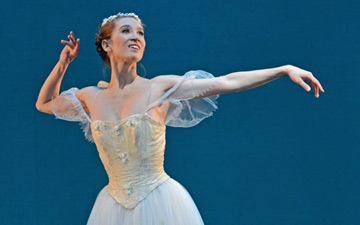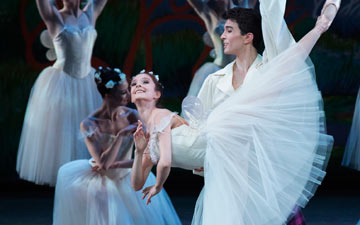
© Dave Morgan. (Click image for larger version)
Ulrik Birkkjaer and dancers from the Royal Danish Ballet
The Bournonville Legacy: La Sylphide Act II and A Bournonville Square (excerpts)
★★★★✰
New York, Joyce Theater
9 and 11 July 2019
artforlife.dk/ulrik-birkkjaer
kglteater.dk
joyce.org
Danish Style
You can tell the Danes are in town by the fact that the Joyce Theater has been packed night after night this week. There is a strong affinity between the dancers of the Royal Danish Ballet (RDB) – particularly when they dance the works of August Bournonville – and American audiences. It may have something to do with a vague family-feeling; George Balanchine loved the Danish school, and hired several Danish dancers, including of course Peter Martins, Erik Bruhn (as a guest), and Ib Andersen, as well as the legendary teacher Stanley Williams, who trained dancers at the School of American Ballet for over thirty years. And then there is Balanchine’s Tarantella (1964), with its fast footwork and playful style – a salute to Bournonville’s Napoli.
The group currently performing in New York isn’t an official envoy of the Royal Danish Ballet, but rather a satellite collective put together by the former RDB dancer Ulrik Birkkjaer, now a principal dancer at San Francisco Ballet. Denmark is too small to retain all of its top male dancers, whose training makes them attractive to other, more international companies. Another recent export is Alban Lendorf, a much-loved and much-injured principal at American Ballet Theatre. Nikolaj Hübbe, the current RDB director, danced with City Ballet for sixteen years.
Birkkjaer has brought three principal dancers, two of them – Ida Praetorius and Jon Axel Fransson – recently-promoted, as well as a mix of soloists and corps dancers. Sorella Englund, an important dancer from the 1960’s and 70’s who has gone one to become one of the company’s most treasured character artists, has come as well. Most, but not all, are Danish. (More than half of the company is now foreign-born.) The repertory is a medley of Bournonville excerpts, beginning with the second act of La Sylphide, and then, in the second half, continuing with a suite of divertissements from The Kings Volunteers on Amager, From Siberia to Moscow, Napoli, and The Kermesse in Bruges. The closer, it goes without saying, is the tarantella from Napoli, in which everyone takes part, dancing, playing the castanets or the tambourine, flirting and whispering on the sides.

© Dave Morgan. (Click image for larger version)
Of course, Bournonville loses a lot without the sets and live music; these ballets are all about stories and the locales in which they occur. The Joyce is not an ideal place to see classical ballet, either: you’re too close to the dancers, and the stage is small. And yet, somehow, for the most part these dancers manage to pull off the feat of making you forget the unfortunate setting. Particularly in the second performance I saw (on July 11), their relaxed, vivid presence quickly erased doubts about the format of the show. I was most struck by the dancers’ faces: open and engaged, with lively eyes. They seemed to put as much energy into their mime as the did into their dancing. There always seemed to be something going on in the background: a secret being told, a flirtation, a bet being laid.
Other things stood out a well: the relaxed way the dancers stood about, often with one leg extended to the side, foot relaxed rather than pointed. The way they looked at each other when dancing together – frankly and directly, aiming their gaze straight into each other’s eyes. The way, even in pas de deux, the dancers tended to take in the people around them, as if always conscious that they were part of a larger group.
I saw two casts of La Sylphide. In both, Ida Praetorious played the Sylph. She was tentative on Tuesday, but more fully present on Thursday. I’ve been told this is her début as the Sylph, which explains why her interpretation doesn’t yet have the intensity or focus that made Gudrun Bojesen so devastating just a few years ago. But what Praetorius does have is an otherworldliness, a kind of remoteness that makes her seem not quite human. She’s gentle but not saccharine. Her dancing is satisfyingly simple, not cluttered with mannerisms. She peers at her partner with a kind of cross-species curiosity.
Tuesday’s James, Birkkjaer, was wonderfully impetuous. From the beginning his desire to possess this strange and beautiful creature was evident. When he wrapped the poisoned scarf around her arms, capturing her, he had the unnerving look of a man who believes he is about to finally get what he wants. It was a little scary. Marcin Kupinski, on Thursday, was more boyish, more delighted and surprised by everything he saw. Both danced the tricky zigzagging lines of Bournonvilles’ choreography with clarity and lightness; Birkkjaer was perhaps more assured and more dynamic in his attack. The steps are ridiculously hard, with double tours in both directions (not always perfectly clean) and long, long phrases in which one jump leads into the next in a continuous line, without rests or stops. Each phrase is like a virtuoso aria.

© Dave Morgan. (Click image for larger version)
The Sylphide excerpt opened with the famous mime scene for the witch, Madge, stirring her witch’s brew. Englund – tiny, wiry, super-animated – gave a vivid rendition, fingers splayed, eyes filled with anger and delight at her own power. The young dancer who performed the scene on Thursday, Tobias Praetorius (corps dancer, brother of Ida) could not have been more different. His Madge was a monstrous, twisted creature, physically powerful, slithering, and deformed, like something out of Lord of the Rings. Later in the evening, he returned to play the fatuous Street Singer (from Napoli), and to dance a tricky solo filled with attitude turns and split jumps in the Pas de Six (also from Napoli). A dancer who can do all three of these things with such gusto and ease is a treasure.
The other highlight of the evening was the pas de deux from The Kermesse in Bruges, danced by Jon Axel Fransson (principal) and Stephanie Chen Gundorph (soloist). Both are exceedingly beautiful humans, with wide open expressions; both are polished, harmonious dancers. Gundorph’s rocking sideways jetés, led by the head, had a wonderful lilt. Her neck was relaxed, which allowed her to use her head expressively. I have only two tiny complaints: One is that the leg extensions, particularly to the side, for the women, are sometimes too high. It looks out of place in the style. The other is that the landings were at times quite heavy, though that might be a function of the size of the theater.

© Costin Radu. (Click image for larger version)
The Kermesse pas de deux is gentle and understated. A young man asks a young woman to dance, and she accepts, after looking toward her mother for permission. Then he offers a flower, and again she looks back at her mother before accepting. It’s a public declaration of love. For most of the duet, they dance apart, performing the same steps, for each other. It is she who approaches him, taking his arm to initiate a promenade. He stands in attitude, and she bourrées in tiny steps around him. This depiction of collegiality between the sexes and good manners is really unique to Bournonville. Fransson is one to watch: clean footwork, relaxed upper body, floating jumps, simple port de bras, open, sparkling eyes. At the top of a jump, he stretches his legs up slightly higher, creating the illusion of lifting himself even higher into the air.
In fact, he is exactly what one imagines when one thinks of the Danish school. It gives one hope in the future of these beautiful works, which deserve to be performed more often, in their full versions, both at home and abroad.

















Thank you for this clearly, lovingly written review. There is an explanation for the dancers who are observing the action on stage, as in Napoli, for standing with their feet relaxed, rather than pointed. They are, Frank Andersen explained here in Portland, when staging Napoli on Oregon Ballet Theatre, real people, real humans, not dancers, so they stand with their feet in a natural position.
I do wish I could have seen this show, the exigencies of the Joyce notwithstanding. Thank you for permitting me to see it through your sharp eyes.
Thank you very much, Martha, for your kind note. I love that “casual” pose…